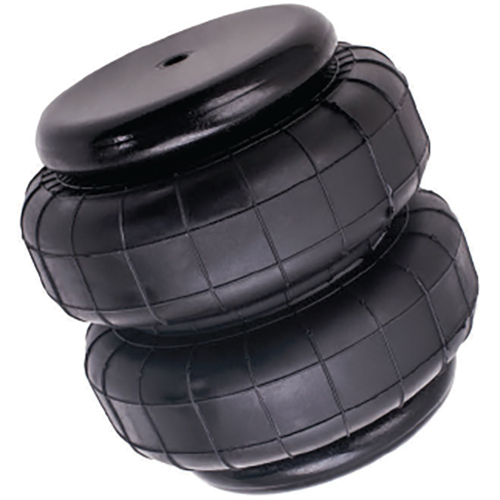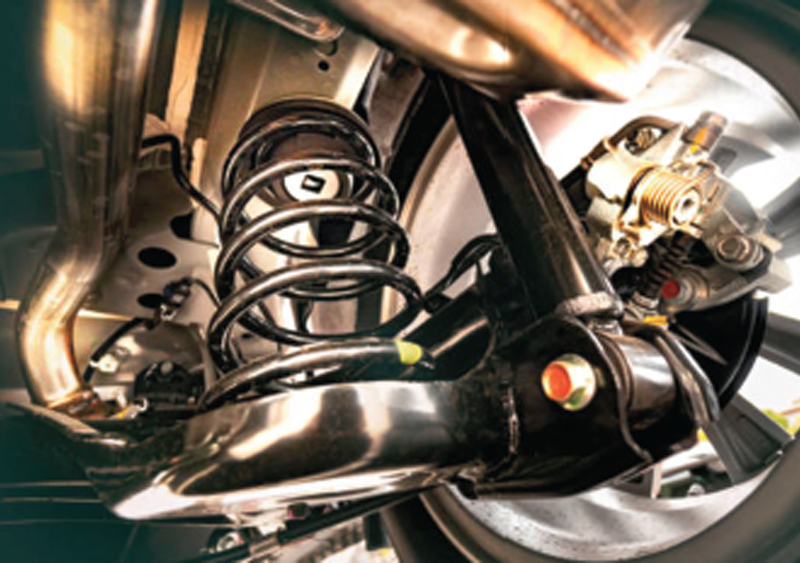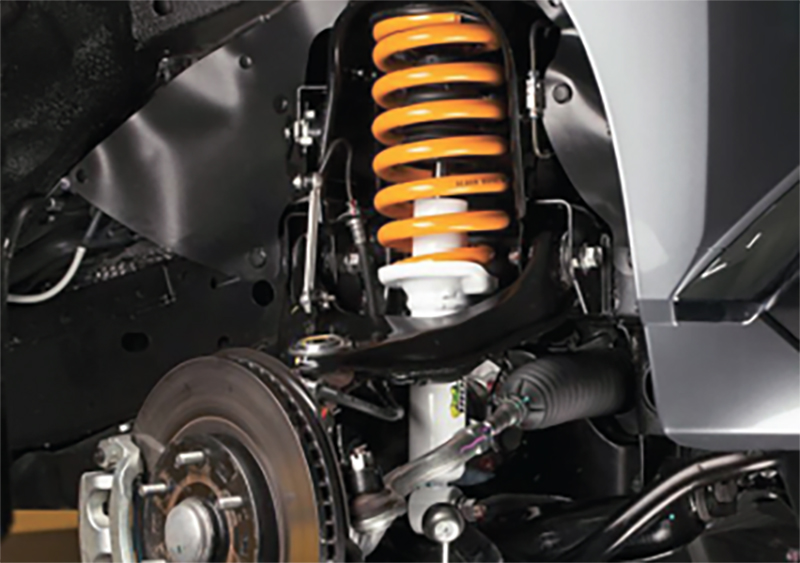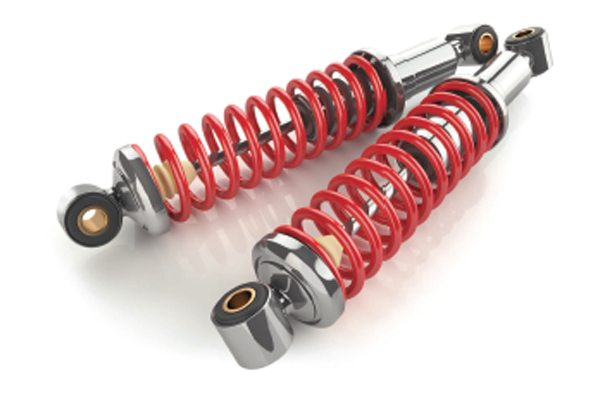As we drive on today’s roads, we often encounter bumps, potholes, and expansion joints that transmit vibration from our tires that affects our comfort, steering, and braking ability.
When you pass over a bump in the road, does your car or truck continue to bounce for the next half-mile…or more? That oscillation, or up-and-down motion, is most likely due to bad shock absorbers. The name “shock absorber” is self-explanatory: Car shocks and truck shocks absorb the up-and-down shock created by the springs when you hit a bump. Shock absorbers do not just smooth the ride; they also keep the car or truck controllable after a bump, and that is always a good thing. Bad shocks are not just uncomfortable, they are also dangerous.
When you quickly turn left to change lanes to avoid an accident or some debris on the road, the springs on the left side compress and the weight of the vehicle transfers to that side, unloading the weight on the springs of the right side. When you now twist the steering wheel back to recover from the swerve, the weight is now transferred back from the left compressed spring to load up the previously uncompressed spring. Without proper shocks, this type of movement will cause excessive body roll and possibly a loss of steering as the pendulum effect starts you fishtailing down the road.
Shocks absorbers prevent the front of the vehicle from constantly bouncing up and down (porpoising) as we drive over bumpy roads. Not only do the shocks help prevent the vehicle from suddenly diving down, but also from jumping up. The shocks keep the tires in contact with the road as we drive over bumps, expansion joints, and potholes.
 Shock absorbers on a vehicle dampen the unwanted effect of the front diving during stops, of the rear end diving during acceleration, help prevent the body from swaying side to side during lane changes and prevent the front from leaning into the corners. The shock absorber generally limits the rebound stroke with a piston that travels through oil to soak up the bounce. Over the years, the wear of some moving parts causes some shock absorbers to leak oil and the shock loses its effectiveness to prevent rebound.
Shock absorbers on a vehicle dampen the unwanted effect of the front diving during stops, of the rear end diving during acceleration, help prevent the body from swaying side to side during lane changes and prevent the front from leaning into the corners. The shock absorber generally limits the rebound stroke with a piston that travels through oil to soak up the bounce. Over the years, the wear of some moving parts causes some shock absorbers to leak oil and the shock loses its effectiveness to prevent rebound.
You may be driving on worn or weak shocks without realizing it. While worn shocks will usually not stop you from traveling, they will reduce your chances of avoiding an accident. If your shocks are worn or not working properly, you will likely notice poor tracking and wander, difficult steering response, too much wagging of the dog at the rear, too much lean in the corners, the front end may dive during braking.
The best way to evaluate your shocks is to drive your car or truck over roads you are familiar with. Those roads should require cornering, braking and have a variety of rough and smooth surfaces. Do not rely on a mechanic or technician to tell you when your shocks are bad. Generally, they will not take the time or drive your vehicle far enough to be able to evaluate your shocks properly. We used to test the shock absorbers on a car by pushing down and quickly releasing the front or rear of the vehicle, then watch the vehicle to notice how it rebounds back to its original position. If the vehicle continued to bounce, the shocks were considered to be worn out and not doing their job.
When a tire bounces off the road surface, it loses speed during the brief time it is in the air, then when it comes back in contact with the road surface, tiny amounts of rubber tread are scrubbed off each time the tire hits the road. This causes scalloping of the tread which will result in a very bumpy ride. Simply changing a scalloped tire with a new one will not cure the bad tire wear.

 The shock absorber is built with pistons inside oil filled tubes that have to push against the fluid to move either way. By forcing a piston through oil, shocks develop the hydraulic friction necessary to resist unwanted and excess suspension motion. Shocks work in two directions called compression (the closing motion) and rebound (the opening motion). Shock absorbers minimize unwanted and uncomfortable body motions such as pitch and side to side rocking.
The shock absorber is built with pistons inside oil filled tubes that have to push against the fluid to move either way. By forcing a piston through oil, shocks develop the hydraulic friction necessary to resist unwanted and excess suspension motion. Shocks work in two directions called compression (the closing motion) and rebound (the opening motion). Shock absorbers minimize unwanted and uncomfortable body motions such as pitch and side to side rocking.
The oil used in shock absorbers has some air in solution. The rapid movement of the shock piston causes cavitation. This results when the air in the oil comes out of solution to form foam. Foamed oil will not pro-vide proper resistance. This affects shock performance. By pressurizing the oil, engineers can eliminate the negative effects of cavitation. The result is more consistent control and superior ride quality.
Many trailers are sold without shock absorbers included in their suspension, just standard leaf springs, or torsion axles. We often hear from owners about clothes that jump off the hangers in the rear closet, or dishes that leap out of the cabinets when travelling over certain roads. Shocks reduce the bounce and wander of your trailer for improved towing capacity, and also reduce the surge caused by trailer motion feedback to the tow vehicle, for a smoother, more comfortable ride.
Aftermarket shock kits are available for travel trailer and fifth wheel units. Many new fifth wheel trailers have an air bag suspension in their hitch to smooth out movements of the trailer that can be transferred to the tow vehicle through the normal hitch. A good shock absorber will dampen the action of the air bag as it compresses and rebounds.
 Most RVs and motorhomes today have basement storage which moves the center of gravity of the vehicle higher off the road. This makes the job of the shock absorber more difficult to dampen the pendulum effect of body roll and sway that may occur with poorer quality shocks. Sudden steering input, or heavy braking combined with steering input, can upset the balance of almost any vehicle. These types of reactions are quite common in emergency situations, but with heavy high center-of-gravity vehicles such inputs can cause serious control problems. Well-designed shock absorbers can make a significant difference in motorhome and truck stability under all conditions.
Most RVs and motorhomes today have basement storage which moves the center of gravity of the vehicle higher off the road. This makes the job of the shock absorber more difficult to dampen the pendulum effect of body roll and sway that may occur with poorer quality shocks. Sudden steering input, or heavy braking combined with steering input, can upset the balance of almost any vehicle. These types of reactions are quite common in emergency situations, but with heavy high center-of-gravity vehicles such inputs can cause serious control problems. Well-designed shock absorbers can make a significant difference in motorhome and truck stability under all conditions.
Many of our newer vehicles have ABS braking systems today. Poor tire to road contact can cause ABS brakes to engage prematurely extending braking distances. Well-designed shocks in good condition are critical to good stopping power.
Mileage alone is a poor indicator of shock performance. Some shocks are still working well after 30,000 to 40,000 miles. Others need replacement in as little as 4,000 miles. In fact, some shocks are so poor that they do not work properly when brand new! Another test was the old “bumper bounce test”. This test is a worst-case evaluation. Shocks are usually per-forming poorly well before this test shows anything. If your vehicle has very stiff springs, like some trucks, the bumper test is almost impossible to perform.
Do not install inferior quality, low-cost shocks on your RV, even if they have an excellent warranty. Remember that warranties do not cover the labour which may cost more than the product itself.























